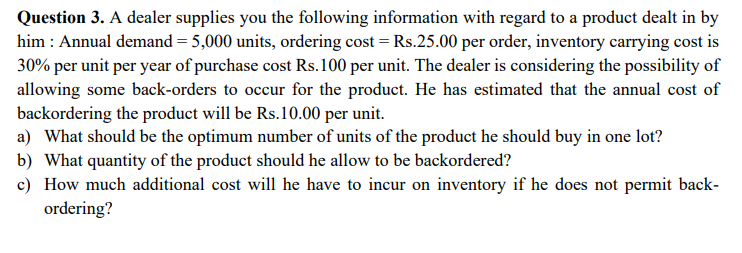Answered step by step
Verified Expert Solution
Question
1 Approved Answer
Question 1. The Great Southern Automotive Co. buys steering wheels from a supplier. One particular steering wheel has a known and constant demand rate



Question 1. The Great Southern Automotive Co. buys steering wheels from a supplier. One particular steering wheel has a known and constant demand rate of 2,000 units per year. The fixed cost of ordering is $100 and the inventory holding cost is $2 per unit per year. It takes 2 weeks for an order to arrive. Compute: a) The optimal EOQ b) The reorder point c) The average inventory level d) The time between successive orders e) The total annual cost f) If demand was variable with a standard deviation of 4 units per week, and the firm aims for 98% customer satisfaction, what would be the safety stock and reorder point? Question 2. General Mills faces annual demand for its Wheat Chex and Corn Chex cereals of 480,000 and 840,000 boxes respectively. Each box contains 18 ounces of cereal, and 50% of the weight of the cereal comes from its grain (wheat or corn). General Mills has computed its ordering cost as $60 per order. They pay their supplier 12.5 cents per pound (there are 16 ounces in a pound) of wheat and 10 cents per pound of corn. The annual holding cost of either grain is 20% of the value of the grain. a) What are the optimum order sizes for wheat and corn when purchased separately? b) If you combine orders for each grain into one monthly order, it will still only cost $60 for the combined order. If an order is placed every month, what is the difference in the total annual procurement related cost between this new policy and the policy calculated above (in 3a) Question 3. A dealer supplies you the following information with regard to a product dealt in by him: Annual demand = 5,000 units, ordering cost = Rs.25.00 per order, inventory carrying cost is 30% per unit per year of purchase cost Rs.100 per unit. The dealer is considering the possibility of allowing some back-orders to occur for the product. He has estimated that the annual cost of backordering the product will be Rs.10.00 per unit. a) What should be the optimum number of units of the product he should buy in one lot? b) What quantity of the product should he allow to be backordered? c) How much additional cost will he have to incur on inventory if he does not permit back- ordering?
Step by Step Solution
There are 3 Steps involved in it
Step: 1

Get Instant Access to Expert-Tailored Solutions
See step-by-step solutions with expert insights and AI powered tools for academic success
Step: 2

Step: 3

Ace Your Homework with AI
Get the answers you need in no time with our AI-driven, step-by-step assistance
Get Started


